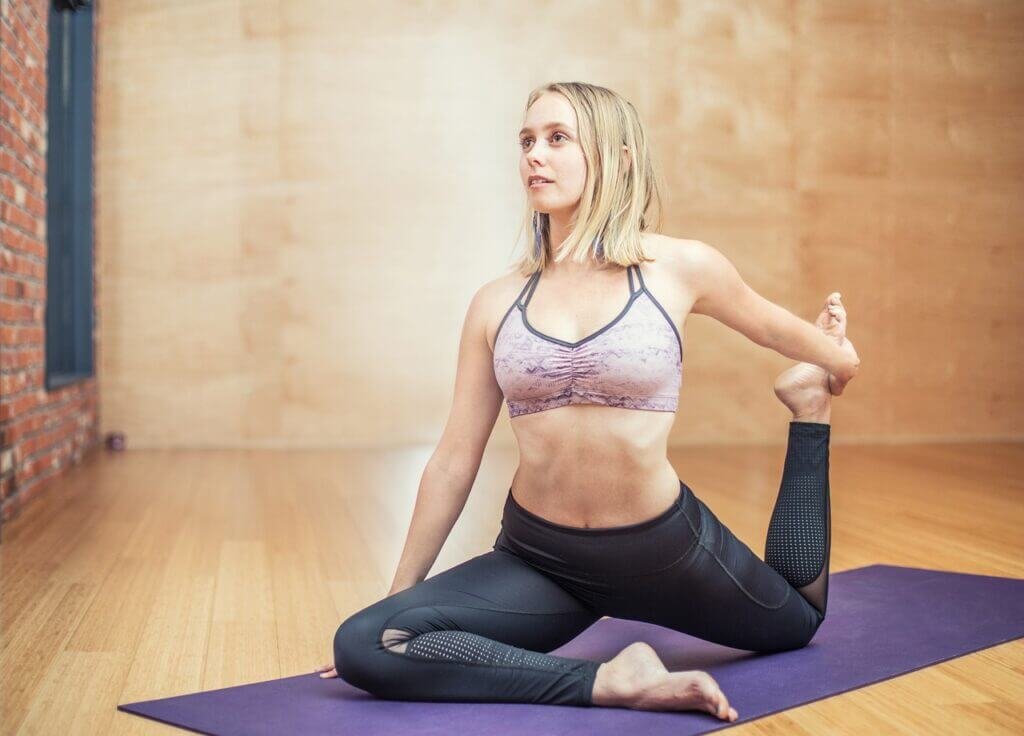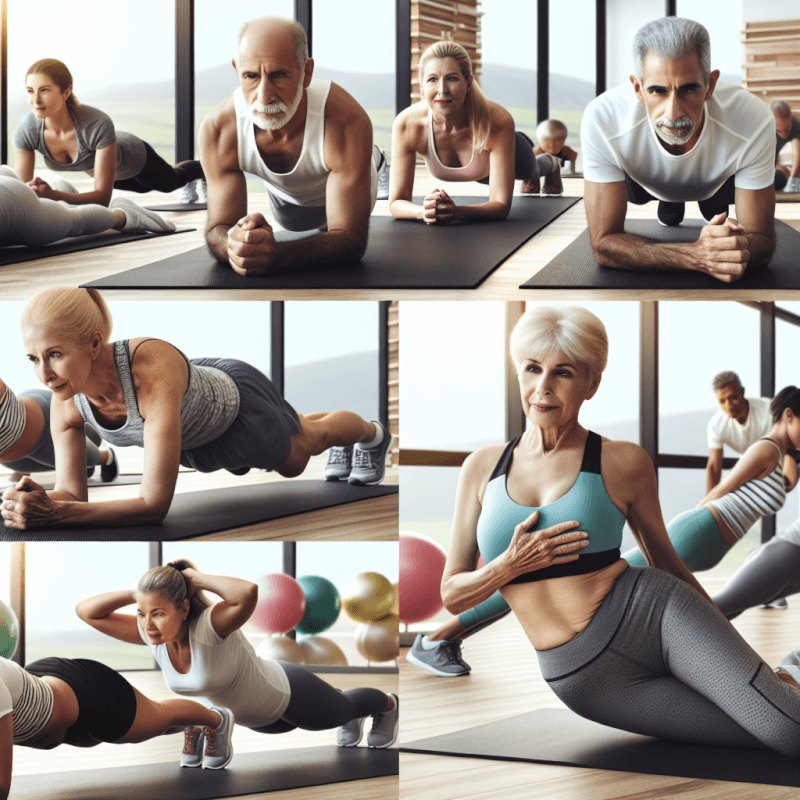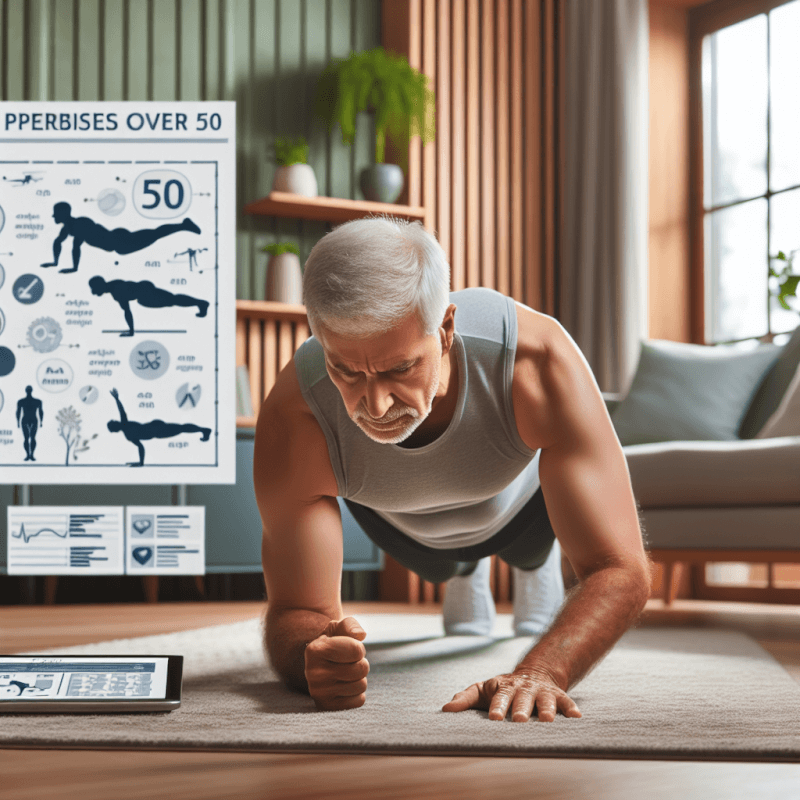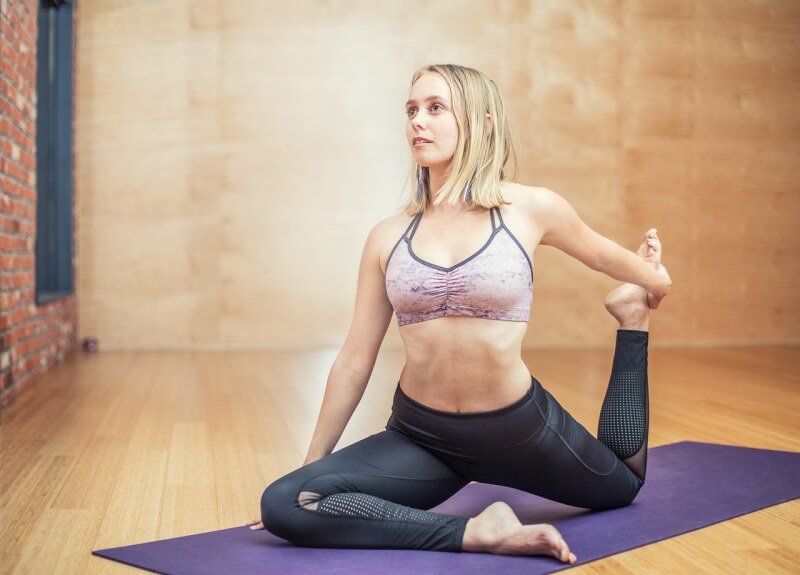Are you in your 50s and looking to tone your abs? Look no further! In this article, we will share some of the best ab workouts specifically designed for individuals over 50. As we age, it’s crucial to maintain strong core muscles not only for a toned physique but also for overall stability and balance. Whether you’re a beginner or have been working out for years, these exercises will help you strengthen your core and achieve your fitness goals. Let’s get started on this journey towards a stronger, healthier you!

Benefits of Ab Workouts
Ab workouts are not only beneficial for achieving a toned and sculpted midsection, but they also offer several other advantages for individuals over 50. Incorporating ab exercises into your fitness routine can help improve your overall health and well-being. Here are three key benefits of engaging in regular ab workouts:
1. Strengthening Core Muscles
One of the primary benefits of ab workouts is the strengthening of your core muscles. Your core includes the muscles in your abdomen, lower back, pelvis, and hips. These muscles play a crucial role in maintaining stability and providing support to your spine. As you age, your core muscles tend to weaken, leading to a higher risk of back pain and instability. By engaging in ab workouts, you can target and strengthen these muscles, improving your overall core strength and stability.
2. Improving Balance and Stability
Another significant benefit of ab workouts for individuals over 50 is improved balance and stability. As we age, maintaining our balance becomes increasingly important to prevent falls and related injuries. Your core muscles are directly involved in maintaining balance and stability. By incorporating ab exercises into your fitness routine, you can enhance your proprioception and strengthen the muscles responsible for stability. This, in turn, reduces the risk of falls and promotes better overall balance.
3. Reducing Lower Back Pain
Many individuals over 50 experience lower back pain, which can significantly impact their daily lives and overall well-being. Ab workouts can help alleviate and prevent lower back pain by strengthening the muscles that support your spine. When your core muscles are weak, they place increased strain on your lower back, leading to discomfort and pain. By performing targeted ab exercises, you can improve the stability of your spine, reduce the load on your lower back, and alleviate or prevent lower back pain.
Factors to Consider
Before starting any ab workout routine, it’s essential to consider certain factors to ensure your exercises are safe and suitable for your individual needs. Here are three factors you should take into account:
1. Health Condition and Medical History
Your health condition and medical history play a vital role in determining the type and intensity of ab workouts that are suitable for you. Certain medical conditions or past injuries may require modifications to exercises or the avoidance of specific movements. It is always advisable to consult with a healthcare professional, such as a doctor or physical therapist, before starting any new exercise routine, especially if you have any pre-existing medical conditions or injuries.
2. Fitness Level and Goals
Your current fitness level and goals should also be considered when selecting ab workouts. If you are new to exercising or have a low fitness level, it is important to start with beginner-friendly exercises and gradually progress as your strength improves. On the other hand, if you have been consistently exercising and have a higher fitness level, you may opt for more challenging exercises to continue challenging your abdominal muscles. Additionally, understanding your goals, whether it be overall core strength, weight loss, or general fitness, will help you choose the right exercises for your needs.
3. Time Availability
Time availability is an essential factor to consider when designing your ab workout routine. It’s crucial to choose exercises that fit within your schedule and that you can consistently commit to on a regular basis. If you have limited time, selecting exercises that target your abs effectively in a shorter duration can enable you to stay dedicated and achieve your fitness goals without feeling overwhelmed.

Key Principles for Effective Ab Workouts
To ensure you get the most out of your ab workouts, it is essential to adhere to these key principles:
1. Proper Form and Technique
Maintaining proper form and technique during ab exercises is crucial to prevent injuries and achieve optimal results. It’s important to focus on engaging the correct muscles and avoiding excessive strain on other parts of your body. If you are uncertain about the correct form, consider working with a certified personal trainer who can guide you and provide feedback on your technique.
2. Gradual Progression
Gradual progression is essential to continuously challenge and strengthen your abdominal muscles. As you become more comfortable with certain exercises, it’s important to gradually increase the intensity, duration, or difficulty level. This can be achieved by adding additional repetitions, incorporating more challenging variations, or using resistance such as weights or resistance bands. Gradual progression ensures that your muscles continue to adapt and grow stronger over time.
3. Consistency and Discipline
Consistency and discipline are key to achieving long-term results from ab workouts. It’s important to establish a regular exercise routine and stick to it. Consistency allows your muscles to adapt and improve, leading to noticeable changes in your core strength and overall physique. Aim to incorporate ab exercises into your weekly routine at least two to three times a week for optimal results.
Modified Crunches
Modified crunches are an excellent starting point for individuals over 50, as they provide a safe and effective way to engage and strengthen the abdominal muscles. Here are three variations of modified crunches that you can incorporate into your ab workout routine:
1. Seated Crunches
Seated crunches are a beginner-friendly exercise that can be performed on a mat or a stable chair. Start by sitting upright with your feet flat on the floor and your hands behind your head. Engage your abdominal muscles and lean back slightly while maintaining a tall posture. Slowly lift your upper body, bringing your chest towards your knees. Hold for a moment and then lower back down to the starting position. Aim for two sets of 12 reps, gradually increasing the number of repetitions as your strength improves.
2. Supine Leg Lifts
Supine leg lifts target not only the abdominal muscles but also the hip flexors. Lie flat on your back with your legs extended. Place your hands palms-down underneath your buttocks for support. Keep your core engaged and slowly lift both legs together towards the ceiling, using your abdominal muscles to control the movement. Lower your legs back down, keeping them straight and maintaining control throughout the exercise. Perform two sets of 12 reps, gradually increasing the number of repetitions as you get stronger.
3. Oblique Crunches
Oblique crunches target the side abdominal muscles, also known as the obliques. Begin by lying on your back with your knees bent and feet flat on the ground. Place your hands behind your head, elbows pointing out to the sides. Engage your core and lift your upper body, simultaneously rotating your torso to one side and bringing your elbow towards the opposite knee. Return to the starting position and repeat on the other side. Aim for two sets of 12 reps per side, gradually increasing the number of reps as your oblique strength improves.

Plank Variations
Plank exercises are highly effective for strengthening the core muscles, including the rectus abdominis, transverse abdominis, and obliques. Here are three variations of plank exercises suitable for individuals over 50:
1. Standard Plank
The standard plank is a foundational exercise for core strengthening. Begin in a push-up position, resting on your forearms and toes. Ensure that your body forms a straight line from your head to your heels, with your core engaged and your glutes squeezed. Hold this position for 30 seconds, gradually working up to longer durations as your core strength improves. Remember to breathe evenly throughout the exercise and maintain proper form.
2. Side Plank
Side planks target the oblique muscles and improve lateral core stability. Start by lying on your side with your legs extended and one forearm resting on the ground perpendicular to your body. Stack your feet on top of each other and lift your hips off the ground, creating a straight line from your head to your feet. Hold this position for 30 seconds on each side, gradually increasing the duration as you become more comfortable. To modify the exercise, you can perform the side plank with your knees bent.
3. Reverse Plank
The reverse plank targets the abdominal muscles, lower back, and shoulders. Begin by sitting on the ground with your legs extended in front of you. Place your hands behind your hips, fingers pointing towards your feet. Press through your hands and lift your hips off the ground, creating a straight line from your head to your heels. Keep your core engaged and avoid sinking into your shoulders. Hold this position for 30 seconds, gradually increasing the duration as your strength improves.
Standing Core Exercises
Standing core exercises are an excellent way to engage your abdominal muscles while incorporating functional movements. Here are three standing core exercises that are suitable for individuals over 50:
1. Woodchoppers
Woodchoppers simulate the motion of chopping wood and target the oblique muscles, shoulders, and hips. Stand with your feet hip-width apart, holding a dumbbell or medicine ball with both hands. Bring your arms diagonally across your body, pivoting on your back foot and rotating your torso as you bring the weight down towards the outside of your opposite knee. Return to the starting position and repeat on the other side. Aim for two sets of 10 reps per side, gradually increasing the weight or repetitions as you become stronger.
2. Standing Knee Lifts
Standing knee lifts are a simple yet effective exercise to engage the lower abdominal muscles and improve balance. Stand tall with your feet hip-width apart and your arms relaxed by your sides. Lift one knee towards your chest while maintaining a stable posture. Lower your leg back down and repeat with the other leg. As you lift your knee, focus on engaging your abdominals and maintaining a slow and controlled movement. Perform two sets of 10 reps per side, gradually increasing the number of reps as you improve.
3. Russian Twists
Russian twists target the oblique muscles and improve rotational core strength. Sit on the ground with your knees bent and feet flat on the floor. Lean back slightly to engage your core muscles. Hold a dumbbell or medicine ball with both hands, arms extended in front of you. Twist your torso to one side, bringing the weight towards the ground. Engage your obliques and rotate to the other side, continuing the twisting motion. Aim for two sets of 10 reps per side, gradually increasing the weight or repetitions as your strength improves.

Stability Ball Exercises
Stability balls, also known as exercise or Swiss balls, add an element of instability to your ab workouts, engaging more muscles in the process. Here are three stability ball exercises suitable for individuals over 50:
1. Rollouts
Rollouts target the entire core, including the rectus abdominis, transverse abdominis, and obliques. Start by kneeling on the floor with a stability ball positioned in front of you. Place your forearms on top of the ball and engage your core. Slowly roll the ball forward, extending your arms and lowering your torso towards the ground. Keep your core engaged to prevent your lower back from sagging. Roll the ball back in towards your knees to return to the starting position. Aim for two sets of 10 reps, gradually increasing the range of motion as your strength improves.
2. Medicine Ball Sit-Ups
Medicine ball sit-ups add an extra challenge to traditional sit-ups, engaging your abdominal muscles more effectively. Sit on the floor with your knees bent and your feet flat on the ground. Hold a medicine ball against your chest with both hands. Lie back slowly, engaging your core, and perform a sit-up, bringing your torso towards your thighs while keeping the medicine ball close to your chest. Lower yourself back down with control. Aim for two sets of 10 reps, gradually increasing the weight or repetitions as you become stronger.
3. Mountain Climbers
Mountain climbers are a dynamic stability ball exercise that targets the entire core, as well as the shoulders and upper body. Start in a high plank position with your hands on the floor and your shins resting on the stability ball. Engage your core and bring one knee towards your chest, then alternate quickly, as if you were running in place. Maintain a straight line from your head to your heels throughout the exercise. Perform mountain climbers for 30 seconds, gradually increasing the duration as your stamina improves.
Pilates and Yoga for Core Strength
Incorporating Pilates and yoga into your ab workout routine can provide additional benefits for core strength, flexibility, and overall well-being. Here are three exercises from each discipline that target the core muscles:
1. Pilates Single Leg Stretch
The Pilates single leg stretch engages the deep core muscles while promoting flexibility and control. Lie on your back with your knees bent and feet lifted off the ground, shins parallel to the floor. Bring one knee towards your chest and extend the opposite leg, hovering it above the floor. Hold the back of your thigh with both hands and switch legs, drawing the other knee towards your chest while extending the opposite leg. Repeat this scissoring motion, focusing on maintaining a stable and engaged core. Aim for one set of eight reps per side, gradually increasing the number of reps as your strength improves.
2. Yoga Boat Pose
Boat pose is a challenging yoga posture that strengthens the entire core, particularly the rectus abdominis and hip flexors. Sit on the floor with your knees bent and your feet flat on the ground. Lean back slightly to engage your core and lift your feet off the ground, balancing on your sit bones. Extend your arms straight in front of you, parallel to the floor. Aim to create a V shape with your body, while keeping your spine long and your chest lifted. Hold this position for eight breaths, gradually increasing the duration as your core strength improves.
3. Pilates Bridge
The Pilates bridge exercise targets the glutes, hamstrings, and lower back, while also engaging the core muscles for stability. Lie on your back with your knees bent and feet flat on the ground, hip-width apart. Place your arms alongside your body, palms facing down. Press into your heels and lift your hips off the ground, creating a straight line from your knees to your shoulders. Keep your core engaged and avoid pushing your lower back into the floor. Hold the bridge position for eight breaths, gradually increasing the duration as you develop more strength.

Important Tips and Precautions
When engaging in ab workouts, it’s crucial to keep these important tips and precautions in mind:
1. Warm Up Before Starting
Before starting any ab workout routine, it’s essential to warm up your muscles to prevent injuries. Spend at least five to ten minutes engaging in light cardiovascular activities such as jogging in place or skipping rope. This increases blood flow to your muscles and prepares your body for the physical demands of the workout.
2. Listen to Your Body
It’s essential to listen to your body and pay attention to any signs of discomfort or pain during ab workouts. If you experience sharp or persistent pain, stop the exercise and consult with a healthcare professional. It’s normal to feel some muscle fatigue and discomfort during and after a workout, but you should not push through sharp or severe pain.
3. Don’t Overstrain
While it’s important to challenge yourself during ab workouts, it’s crucial not to overstrain your muscles or push beyond your limits. Gradual progression is key to long-term success. Start with exercises that are suitable for your current fitness level and gradually increase the intensity or difficulty as your strength improves. Pushing too hard too soon can lead to injuries and setbacks.
Sample Ab Workout Routine
Here’s a sample ab workout routine that incorporates exercises from the previously mentioned sections. Remember to adjust the intensity and repetitions based on your fitness level and goals:
Warm up: Start with jogging in place or skipping rope for five to ten minutes to raise your heart rate and warm up your muscles.
Exercise 1: Modified crunches – Perform two sets of 12 reps of seated crunches, focusing on proper form and engaging your abdominal muscles.
Exercise 2: Plank variations – Start with a 30-second standard plank, followed by 30 seconds on each side for side planks and 30 seconds for the reverse plank. Rest for 30 seconds between each plank variation.
Exercise 3: Standing core exercises – Perform two sets of 10 reps per side of woodchoppers, standing knee lifts, and Russian twists. Focus on controlled movements and engaging your core.
Exercise 4: Stability ball exercises – Complete two sets of 10 reps each of rollouts, medicine ball sit-ups, and mountain climbers. Keep your core engaged and maintain proper form throughout each exercise.
Exercise 5: Pilates or yoga for core strength – Finish your ab workout routine with one set of eight reps per side of Pilates single leg stretch and hold the boat pose for eight breaths. Focus on activating your core muscles and maintaining your balance.
Cool down: Complete your workout with stretching exercises for the core and lower back. Focus on gentle stretches that target the abdominal muscles, such as child’s pose, cat-cow stretch, and seated forward fold.
Remember to consult with a healthcare professional or a certified personal trainer before starting any new exercise routine, especially if you have any pre-existing medical conditions or injuries.
In conclusion, ab workouts offer numerous benefits for individuals over 50, including strengthening core muscles, improving balance and stability, and reducing lower back pain. By considering factors such as health condition, fitness level, and time availability, you can tailor your ab workout routine to suit your needs. Incorporating proper form, gradual progression, consistency, and discipline are key principles for effective ab workouts. Modified crunches, plank variations, standing core exercises, stability ball exercises, and Pilates or yoga for core strength are all excellent options to include in your routine. By following important tips and precautions and maintaining a well-rounded ab workout routine, you can achieve a strong and healthy core at any age. So grab a mat, stay consistent, and enjoy the benefits of a strong and well-conditioned midsection!


